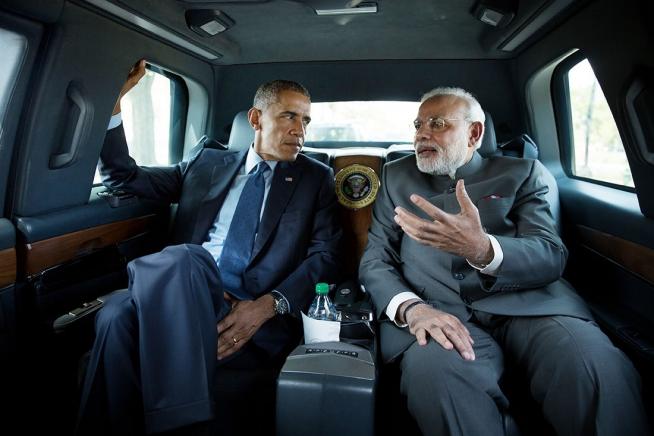Symbolism and strategy on 26 January
Posted By David Lang on January 23, 2015 @ 06:00
 [1]
[1]Mention 26 January and the thoughts of Australians jump quickly to barbeques, beaches and cricket. But this post isn’t about Australia Day. Many [2] Australians will be aware that Indians celebrate their Republic Day on 26 January. This year, the 66th since the Indian constitution entered into force in 1950, will be no different. Festivities in New Delhi will centre around the Republic Day Parade, a showcase of the country’s defence capabilities—‘the glories and follies old and new of the Indian armed forces, from camel regiments to tanks to ballistic missiles [3]’—alongside the lush diversity of Indian culture. Moreover, Barack Obama is set to attend this year’s parade as the invited chief guest, the first time a US president has received the honour. Obama’s attendance represents a diplomatic coup for Indian PM Narendra Modi. It’s yet another sign that relations between India and the US are being reinvigorated, and serves as a reminder of the foreign policy dynamism Modi has displayed since his election last May.
The Republic Day parade will be rich in symbolism for both leaders. The imagery of an American president watching on as India flexes its military muscle won’t escape the attention of India’s neighbours. That Obama’s trip marks the first time a US president has visited India twice while in office (he visited in 2010) will bring additional diplomatic cachet. The chief guest role will offer simple yet important sponsorship of the ‘rebalance’; it’ll similarly illustrate Modi’s support for a continuing American role in Asia.
Obama’s trip to India comes just four months after Modi was in the US—a sign of the momentum in the bilateral relationship. The joint statement [4] that came out of Modi’s September visit illustrated steady progress on a range of security issues. The decision was taken to renew for another 10 years the 2005 Framework for the US–India Defense Relationship, and pledges were made to enhance counter-terrorism cooperation, to deepen military-to-military contact, and to ‘upgrade’ the Malabar naval exercise. The statement reiterated support for India’s phased entry to the key non-proliferation regimes and established a contact group to push forward on civil nuclear cooperation. That Ashton Carter, Obama’s SECDEF nominee, has long championed US–India relations and seems a popular pick [5] in India is unlikely to do the relationship any harm. Still, real challenges to closer US–India relations remain: distraction and competing priorities for Obama, and an historical commitment to strategic autonomy for Modi.
Modi’s decision to invite Obama recalls the symbolism and strategy of former Indian PM Manmohan Singh’s hosting of Japanese PM Shinzō Abe as chief guest last year. High expectations were attached to Abe’s 2014 visit, given his long-standing admiration of India and belief in the great potential of the bilateral relationship. (In his 2006 book, Abe wrote, ‘it would not surprise me if in another decade Japan–India relations overtake US–Japan and Japan–China ties.’)
The Japan–India embrace has tightened considerably since last May; the Abe–Modi bonhomie runs deep beyond bearhugs [6]. Both are nationalistic, conservative leaders; both were elected with mandates to restart their economies and reclaim lost pride; and both are playing for a greater role in underwriting peace and stability in the Asia–Pacific. Both PMs are apprehensive about China’s rise—historical tensions and territorial disputes abound—on the back of which they’ve sought to engage more with the US, regional partners and multilateral security architectures. The upgraded ‘Special Strategic and Global Partnership’ that resulted from Modi’s 5-day visit to Tokyo last September bore witness to growing affinity and shared ambition; so too did last week’s strategic dialogue between foreign ministers, brought back into play after two years on the bench. As Abe increases military spending for a third consecutive year (following 11 years of decline), the steady development of a balancing arc between Tokyo and New Delhi, across China, is an indication of the ‘proactive contribution’ to regional peace and stability that both leaders seek to make.
While the US has been drawn to various global flash points, the rebalance has quietly trundled along. It has become a standard administration line to encourage allies and partners in the Asia–Pacific to deepen and broaden cooperation. So the Asian elements of the one-time Quad [7]—Japan, India and Australia—are holding the line in this respect. Australia should continue to aver strong support for the more active role that both Japan and India, separately and together, seek to play in the region. And with a freshly minted Framework for Security Cooperation [8] with India and a ‘quasi-alliance [9]’ with Japan, Australia should look for and jump at opportunities to foster cooperation. What happens in and from those relationships will serve as important support for a US rebalance that’s materially underway but politically underpowered.
Article printed from The Strategist: https://aspistrategist.ru
URL to article: /symbolism-and-strategy-on-26-january/
URLs in this post:
[1] Image: https://aspistrategist.ru/wp-content/uploads/2015/01/Obama-Modi.jpg
[2] Many: http://www.smh.com.au/comment/what-narendra-modi-means-to-indianaustralians-20141118-11p5fi.html
[3] the glories and follies old and new of the Indian armed forces, from camel regiments to tanks to ballistic missiles: http://www.lowyinterpreter.org/post/2009/09/11/Roggeveen-rule-ruined-on-Rajpath.aspx
[4] joint statement: http://www.whitehouse.gov/the-press-office/2014/09/30/us-india-joint-statement
[5] popular pick: http://www.lowyinterpreter.org/post/2014/12/04/Why-India-likes-Ashton-Carter.aspx?COLLCC=1003203821&
[6] bearhugs: http://blogs.wsj.com/indiarealtime/2014/09/09/modi-embraces-abe-still-holds-china-close/
[7] Quad: http://en.wikipedia.org/wiki/Quadrilateral_Security_Dialogue
[8] Framework for Security Cooperation: http://www.narendramodi.in/framework-for-security-cooperation-between-india-and-australia/
[9] quasi-alliance: http://www.smh.com.au/national/australiajapan-military-ties-are-a-quasialliance-say-officials-20141026-11c4bi.html
Click here to print.